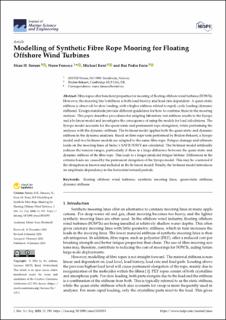| dc.contributor.author | Sørum, Stian Høegh | |
| dc.contributor.author | Fonseca, Nuno | |
| dc.contributor.author | Kent, Michael | |
| dc.contributor.author | Faria, Rui Pedro | |
| dc.date.accessioned | 2023-05-11T08:02:02Z | |
| dc.date.available | 2023-05-11T08:02:02Z | |
| dc.date.created | 2023-02-10T14:10:00Z | |
| dc.date.issued | 2023 | |
| dc.identifier.issn | 2077-1312 | |
| dc.identifier.uri | https://hdl.handle.net/11250/3067594 | |
| dc.description.abstract | Fibre ropes offer beneficial properties for mooring of floating offshore wind turbines (FOWTs). However, the mooring line’s stiffness is both load-history and load-rate dependent. A quasi-static stiffness is observed for slow loading, with a higher stiffness related to rapid, cyclic loading (dynamic stiffness). Design standards provide different guidelines for how to combine these in the mooring analysis. This paper describes procedures for adapting laboratory test stiffness results to the Syrope and a bi-linear model and investigates the consequence of using the models for load calculations. The Syrope model accounts for the quasi-static and permanent rope elongation, while performing the analyses with the dynamic stiffness. The bi-linear model applies both the quasi-static and dynamic stiffness in the dynamic analyses. Based on fibre rope tests performed by Bridon-Bekaert, a Syrope model and two bi-linear models are adapted to the same fibre rope. Fatigue damage and ultimate loads on the mooring lines of Saitec’s SATH FOWT are calculated. The bi-linear model artificially reduces the tension ranges, particularly if there is a large difference between the quasi-static and dynamic stiffness of the fibre rope. This leads to a longer predicted fatigue lifetime. Differences in the extreme loads are caused by the permanent elongation of the Syrope model. This may be countered if the elongation is known and included in the bi-linear model. Finally, the bi-linear model introduces an amplitude-dependency in the horizontal natural periods. | en_US |
| dc.language.iso | eng | en_US |
| dc.publisher | MDPI | en_US |
| dc.rights | Navngivelse 4.0 Internasjonal | * |
| dc.rights.uri | http://creativecommons.org/licenses/by/4.0/deed.no | * |
| dc.subject | Floating offshore wind turbines | en_US |
| dc.subject | Synthetic mooring lines | en_US |
| dc.subject | Quasi-static stiffness | en_US |
| dc.subject | Dynamic stiffness | en_US |
| dc.title | Modelling of Synthetic Fibre Rope Mooring for Floating Offshore Wind Turbines | en_US |
| dc.title.alternative | Modelling of Synthetic Fibre Rope Mooring for Floating Offshore Wind Turbines | en_US |
| dc.type | Journal article | en_US |
| dc.type | Peer reviewed | en_US |
| dc.description.version | publishedVersion | en_US |
| dc.rights.holder | © 2023 by the authors. Licensee MDPI, Basel, Switzerland. This article is an open access article distributed under the terms and conditions of the Creative Commons Attribution (CC BY) license (https:// creativecommons.org/licenses/by/ 4.0/). | en_US |
| dc.source.volume | 11 | en_US |
| dc.source.journal | Journal of Marine Science and Engineering | en_US |
| dc.source.issue | 193 | en_US |
| dc.identifier.doi | 10.3390/jmse11010193 | |
| dc.identifier.cristin | 2125011 | |
| dc.relation.project | EC/H2020/851703 | en_US |
| cristin.ispublished | true | |
| cristin.fulltext | original | |
| cristin.qualitycode | 1 | |

